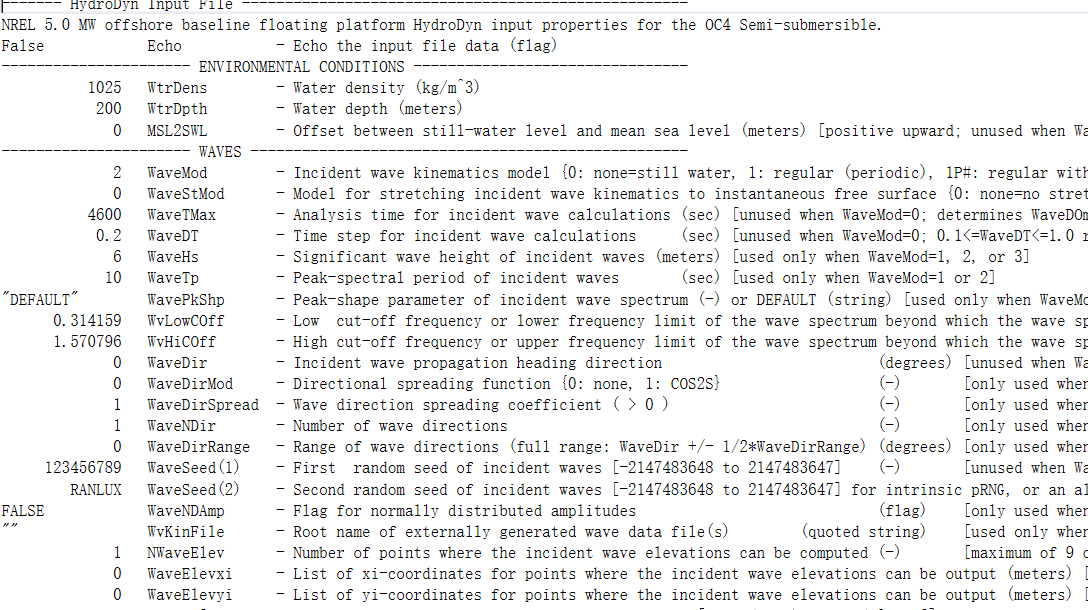Dear sir,
I calculated the first-order and second-order excitation loads in the OC4’s surge direction in HydroDyn, and obtained the spectrogram through FFT, but it is very different from the spectrogram in your article. Your first-order excitation load curve is smooth, and the second-order sum frequency load lasts until 1Hz. I would like to ask if there is a problem with my settings. Is this related to the floating foundation (your article is the OC3 platform), and the output parameters of the HydroDyn wave excitation loads “B1WvsFxi” “B1WvsF1xi” "“B1WvsF2xi”.I have already modified the cutoff frequencies of the difference frequency and sum frequency, but the result still does not change
Best regards,
Dear @Hairui.Jiang,
I can’t really comment much without knowing more about your model set up. Just a few comments so far:
- The second-order difference-requency and sum-frequency effects will depend on the floating platform and sea state.
- The smoothness of the force curves will depend on the simulation settings and post-processing applied.
- Which paper are you comparing your results to?
- You shared an excerpt from your HydroDyn input file from the 2ND-ORDER WAVES section, but what are the other settings? Are you using the full QTFs provied by NREL for the OC4-DeepCwind semi model?
Best regards
Dear sir,
Thank you for your reply. My specific HydroD file settings have been uploaded. I am using the OC4 semi-submersible platform in the case. I want to know whether the natural frequency of the OC4 semi-submersible platform floating turbine is within the second-order wave frequency range, just as described in your article(“Effects of Second-Order Hydrodynamic Forces on Floating Offshore Wind
Turbines”), I set the same sea conditions as you, but the results are quite different. Is it because of the different floating platforms? I use QTFs to calculate the second-order wave force.
Best regards,
Dear @Hairui.Jiang,
Your input file settings look fine, but please note that it appears that you have enabled the second-order sum-frequency QTF (SumQTF = 12), but you have not enabled the second-order difference-frequency QTF (DiffQTF = 0). Are you using the first- and second-order WAMIT data provided by NREL or did you derive this data yourself?
The natural frequencies of the OC4-DeepCwind semisubmersible are summarized in Figure 3 of the following paper: https://www.nrel.gov/docs/fy14osti/61154.pdf.
Regardless, I would expect differences in results between the OC3-Hywind spar and the OC4-DeepCwind semisubmersible.
Best regards,
Dear sir,
Thank you for your reply. Recently, I calculated the second-order excitation force files (10d and 10s) by myself through WAMIT, but there was an error when I put it into FAST. I would like to ask the reason for this error and If I generated the second-order excitation force files through WAMIT by myself,what should be paid attention to do,frequency setting?
Best regards,
Dear @Hairui.Jiang,
Guidance for generating the second-order data from WAMIT is provided in the “Modeling Guidance” section of the HydroDyn User’s Guide and Theory Manual: 4.2.8.4. Modeling Considerations — OpenFAST v3.3.0 documentation. In your case, the error seem to indicate that you have different results for the same wave frequency and wave direction; is that what your *.10d file has?
Best regards,
Dear Jason,
I am trying to compute the second-order forces on OC4 semisubmersible using the full QTFs provided by NREL as a benchmark. (5MW_OC4Semi_WSt_WavesWN)
- I was wondering do the QTFs are created for the sea state in the test files. (Hs=1.2646 m, Tp=10 s and Wind Speed =Steady 8m/s)
- Hydrodynamic analysis of OC3-Hywind spar buoy - #44 by Jason.Jonkman In this post, you provided the wamit files for the computations of the second order OC4 model, does this model also constructed for the same environmental parameters? (Mass and stiffness matrix)
- To obtain mass and stiffness matrix, do I need to linearize the system with the 6 platform DOFs enabled in the same environmental conditions? (Hs=1.2646 m, Tp=10 s and Wind Speed =Steady 8m/s) When I try this, Openfast 3.0 cannot find a steady solution when CalcSteady is true. Or is it okay if I linearize without waves?
Best regards,
Dear @Busra.Yildirim,
Here are my responses to your questions:
- QTFs are not dependent on the sea state such that, once you’ve generated the QTFs, you can apply them to any sea state. Unlike the first-order solution, the QTFs do depend on the mass and stiffness matrix. The mass matrix should be independent of the environmental conditions. Depending on the nonlinearity of the mooring system, the stiffness matrix could depend on the mean displacement of the floater (which is wind speed dependent), but we have chosen to use the undisplaced condition to define the stiffness matrix and have not looked at the sensitivity of the QTF to stiffness changes. The QTF could also depend on an external damping, which you could say comes from aerodynamic or viscous effects, but I would say that this would partially double account those effects that are already considered in the time domain simulation. So, in some ways, the QTF solution is only approximate, but from our experience, the QTF tends to underpredict the actual resonant excitation, so, I would think adding damping would worsen the result.
- As in (1), the QTFs provided by NREL for the OC4-DeepCwind semisubmersible depend on the mass and stiffness derived from the undisplaced condition. No external damping was considered and the sensitivity of the stiffness to displacement was not considered.
- You can derive the mass and stiffness through an OpenFAST linearization analysis, but as discussed above, it should be sufficient to linearize in the absence of wind and wave forcing.
Best regards,






